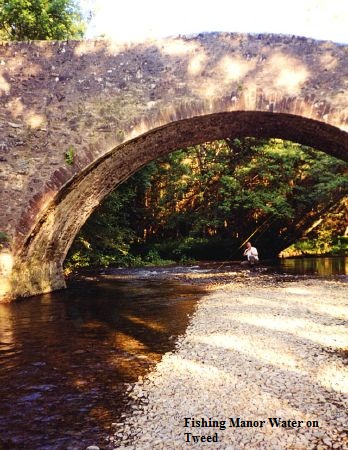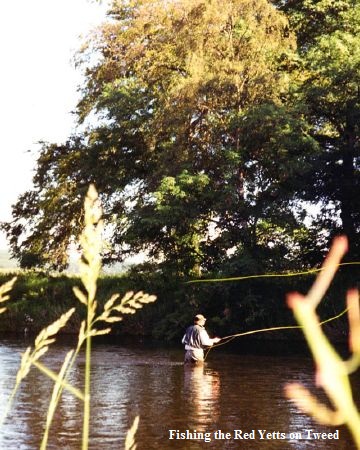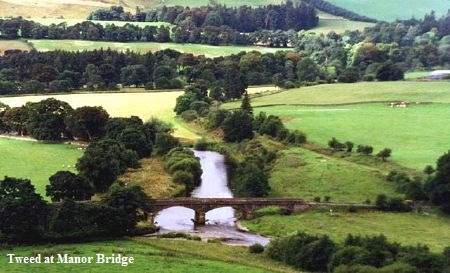Overture and beginners please
- Details
- Published on Wednesday, 27 September 2006 14:47
- Written by Bruce Sandison
 I first committed the sin of angling on Tweed – anglers always say ‘Tweed’, never The Tweed or River Tweed – and I lost my first salmon in the pool below Coo Ford upstream from Innerleithan.
I first committed the sin of angling on Tweed – anglers always say ‘Tweed’, never The Tweed or River Tweed – and I lost my first salmon in the pool below Coo Ford upstream from Innerleithan.
My elder brother and I were staying in a flat in the village, he to study for exams whilst I attended to a boy’s proper function in life, the removal of fish from their natural habitat.
Autumn sunlight sparkled as the stream swept through a narrow neck into a slow, deep pool. I was using a light rod with small flies. When my line stopped I thought that my fly had snagged on an underwater obstruction. I inched forward to retrieve it. Both Wellington boots filled with water. I tugged, tentatively, in order to save the fly. Flies cost money and I could ill-afford to lose one.
Peering into the depths, my heart stopped when I saw the shape of a huge salmon, its sail-like tail moving gently from side to side and my fly, a Silver Butcher, firmly attached to its great jaw. As far as I could make out, the fish didn’t realise that anything was amiss but I was consumed with fear and excitement. If only I could land the salmon, I thought, I would never complain about anything for the rest of my life.
 The salmon and I were locked together. If I moved forward, it sidled away. My rod was arched in anger, the thin line taught. I applied more pressure. The fish shook its head. I stopped, terrified that the line would break. I decided that my only chance would be to try to ‘walk’ the salmon into shallow water. If I succeeded, I had decided that I would throw myself on it and trust to luck that I could wrestle the fish ashore.
The salmon and I were locked together. If I moved forward, it sidled away. My rod was arched in anger, the thin line taught. I applied more pressure. The fish shook its head. I stopped, terrified that the line would break. I decided that my only chance would be to try to ‘walk’ the salmon into shallow water. If I succeeded, I had decided that I would throw myself on it and trust to luck that I could wrestle the fish ashore.
After my second step the salmon become aware of danger. With a mighty swish of its tail it roared upstream. The line burned my fingers as the reel screamed. I saw the fish once more as it leapt from the water, crystal droplets flying from its silver shoulders. My line broke and I tumbled backwards into the shallows. Dragging myself ashore, I wept, tears pouring down my face. My brother had come to look for me and asked what was wrong? “I’ve lost a salmon” I replied. “Is that all,” he said, “Come on, supper’s ready.”
Tweed, ‘the Queen of Scottish rivers’, has ensnared my soul for as long as I can remember. The scent and sound of the stream comforts me no matter where I go. When I joined the army, on journeys south from Edinburgh to London, I would bid a sad farewell to the river as the train rumbled over Border Bridge at Berwick. On returning, no matter what time of day or night I passed, I would hang out of the window to catch a glimpse of Tweed. Seeing the river meant that I really had come home.
 Now, after so many years of confusion and diminishing numbers of fish, I read with joy and happiness that Tweed salmon are back in force and that the river is returning to its former glory. Tweed is, in my view, not only Scotland’s most important river, but also a strategic indicator of the state of the Scottish Nation. If Tweed is healthy, then all must be well in the land God gave to Jock Tamson’s bairns.
Now, after so many years of confusion and diminishing numbers of fish, I read with joy and happiness that Tweed salmon are back in force and that the river is returning to its former glory. Tweed is, in my view, not only Scotland’s most important river, but also a strategic indicator of the state of the Scottish Nation. If Tweed is healthy, then all must be well in the land God gave to Jock Tamson’s bairns.
Tweed is born amongst barren moorlands surrounding Tweed’s Wells, south from Moffat. It flows eastwards for 100 miles through salmon beats synonymous with all that is best in fishing: past the grandeur of Sir Walter Scott’s home at Abbotsford; through the Junction Pool where Tweed meets Teviot; by Sprouston where Canon William Greenwell devised his incomparable trout fly, ‘Greenwell’s Glory’, tied by Tweed’s most famous fly-tyer, James Wright; through the deep pool at Ladykirk where King James 1V nearly drowned in 1500; gathering in the waters from almost 2,000 square miles to deliver them to the grey North Sea at Berwick.
I now live and work in North Sutherland, but a part of me will always remain Tweed. It holds precious memories. My future wife and I fished a tributary of Tweed, Lyne Water, a few miles apart when we were children, although it was six years before we met and married and started our own fishing club; all our children were introduced to Tweed and fly-fishing almost as soon as they could walk. I have fond thoughts of Mr Fraser, a dour Aberdonian and Tweed bailiff appearing as if from nowhere on his ancient bike and calling across the river through the gloaming “Have you got your permit, lad?” “Yes, Mr Fraser!” I would shout back, although I can’t remember him ever holding it in his hands.
But for me, Tweed had always been more about brown trout fishing that chasing Salmo salar, the King of Fish. Days spent on the river seemed endless when I was a boy, the space between unbridled happiness and the stern discipline of school; of triumphs, fishing close to the bank after a spate with a cast made up out of single strands of horse hair and a tiny Greenwell’s Glory and catching half a dozen trout; singing ‘He Shall Feed his Flock’ from the Messiah whilst fishing downstream from Manor Bridge and taking trout so long as I kept on singing; friends met and made on the river bank. 
I taught my father to fish on Tweed. He never did much damage to the fish because he found it hard to take advice. If dad saw a fish rise he would stay, rooted to the spot, casting again and again over it in the firm belief that the fish would eventually surrender and take his fly. It never did. I see him now, in my mind’s eye, as light faded, in the middle of the river, completely oblivious to every worldly care and enjoying every moment he spent in the embrace of ‘My Lady Tweed’. Should such a joy as this be a sin, then I have no regrets whatsoever about pleading guilty to committing it.
Bruce Sandison is a writer and journalist and author of nine books, including the definite anglers' guide, 'The Rivers and Lochs of Scotland' which is being revised and updated prior to republishing.
He contributed to 'Trout & Salmon' for 25 years and was angling correspondent for 'The Scotsman' for 20 years. Sandison writes for the magazine 'Fly Fishing and Fly Tying' and provides a weekly angling column in the 'Aberdeen Press & Journal'.
His work, on angling, Scottish history and environmental subjects, has appeared in most UK national papers, including 'The Sunday Times', 'The Telegraph', 'The Daily Mail', 'The Herald', 'Private Eye', 'The Field' and in a number of USA publications.
Sandison has worked extensively on BBC Radio. His series 'Tales of the Loch' ran for 5 years on Radio Scotland and was also broadcast on BBC Radio 4 and on BBC World Service. His series, 'The Sporting Gentleman's Gentleman' and his programme 'The River of a Thousand Tears', about Strathnaver, established his reputation as a broadcaster.
Sandison has had extensive coverage on television. He wrote and presented two series for the BBC TV Landward programme and has given a number of interviews over the years on factory-forestry, peat extraction, wild fish conservation and fish farming.
Sandison is founding chairman of 'The Salmon Farm Protest Group', an organisation that campaigns for the removal of fish farms from Scottish coastal and freshwater lochs where disease and pollution from these farms is driving wild salmonid populations to extinction.
Bruce Sandison won 'Feature Writer of the Year' in the Highlands and Islands Press Awards in 2000 and in 2002, and was highly commended in 2005. Bruce lives near Tongue in Sutherland with his wife Ann.

